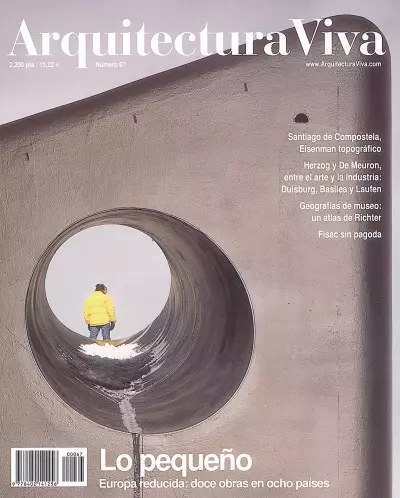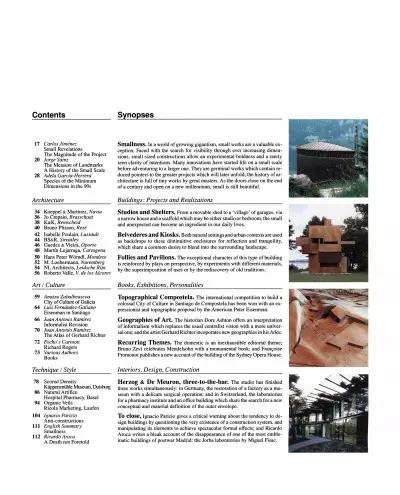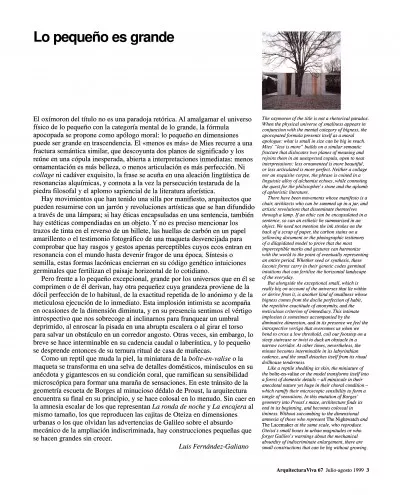Synopses
Smallness. In a world of growing gigantism, small works are a valuable exception. Faced with the search for visibility through ever increasing dimensions, small sized constructions allow an experimental boldness and a rarely seen clarity of intentions. Many innovations have started life on a small scale before adventuring to a larger one. They are germinal works which contain reduced pointers to the greater projects which will later unfold; the history of architecture is full of tiny works by great masters. As the doors close on the end of a century and open on a new millennium, small is still beautiful.
Contents
Carlos Jiménez
Small Revelations
The Magnitude of the Project
Jorge Sainz
The Measure of Landmarks
A History of the Small Scale
Adela García-Herrera
Species of the Minimum
Dimensions in the 90s
Buildings: Projects and Realizations
Studios and Shelters. From a movable shed to a ‘village’ of garages, via a narrow house and a scaffold which may be either studio or bedroom, the small and unexpected can become an ingredient in our daily lives. Architecture
Koeppel & Martínez, Navia
Jo Crepain, Brasschaat
K&K, Remscheid
Bruno Plisson, RezéBelvederes and Kiosks. Both natural settings and urban contexts are used as backdrops to these diminuitive enclosures for reflection and tranquility, which share a common desire to blend into the surrounding landscape. Isabelle Poulain, Lussault
BS&R, Streatley
Guedes & Vieira, Oporto
Martín Lejarraga, CartagenaFollies and Pavilions. The exceptional character of this type of building is reinforced by plays on perspective, by experiments with different materials, by the superimposition of uses or by the rediscovery of old traditions.
Hans Peter Wörndl, Mondsee
M. Loebermann, Nuremberg
NL Architects, Leidsche Rijn
Roberto Valle, V. de los Alcores
Books, Exhibitions, Personalities
Topographical Compostela. The international competition to build a colossal City of Culture in Santiago de Compostela has been won with an expressionist and topographic proposal by the American Peter Eisenman. Art / Culture
Anatxu Zabalbeascoa
City of Culture of Galicia
Luis Fernández-Galiano
Eisenman in SantiagoGeographies of Art. The historian Dore Ashton offers an interpretation of informalism which replaces the usual centralist vision with a more universal one; and the artist Gerhard Richter incoporates new geographies in his Atlas. Juan Antonio Ramírez
Informalist Revision
Juan Antonio Ramírez
The Atlas of Gerhard RichterRecurring Themes. The domestic is an inexhaustible editorial theme; Bruno Zevi celebrates Mendelsohn with a monumental book; and Françoise Fromonot publishes a new account of the building of the Sydney Opera House.
Focho’s Cartoon
Richard Rogers
Various Authors
Books
Interiors, Design, Construction
Herzog & De Meuron, three-to-the-bar. The studio has finished three works simultaneously: in Germany, the restoration of a factory as a museum with a delicate surgical operation; and in Switzerland, the laboratories for a pharmacy institute and an office building which share the search for a new conceptual and material definition of the outer envelope. Technique / Style
Scored Density
Küppersmühle Museum, Duisburg
Natural Artifice
Hospital Pharmacy, Basel
Organic Veils
Ricola Marketing, LaufenTo close, Ignacio Paricio gives a critical warning about the tendency to design buildings by questioning the very existence of a construction system, and manipulating its elements to achieve spectacular formal effects; and Ricardo Aroca writes a bleak account of the disappearance of one of the most emblematic buildings of postwar Madrid: the Jorba laboratories by Miguel Fisac. Ignacio Paricio
Anti-constructions
English Summary
Smallness
Ricardo Aroca
A Death not Foretold
Luis Fernández-Galiano
Small is Big
The oxymoron of the title is not a rhetorical paradox. When the physical universe of smallness appears in conjunction with the mental category of bigness, the apocopated formula presents itself as a moral apologue: what is small in size can be big in reach. Mies’ “less is more” builds on a similar semantic fracture that dislocates two planes of meaning and rejoins them in an unexpected copula, open to neat interpretations: less ornamented is more beautiful, or less articulated is more perfect. Neither a collage nor an exquisite corpse, the phrase is coined in a linguistic alloy of alchemist echoes, while connoting the quest for the philosopher’s stone and the aplomb of aphoristic literature.
There have been movements whose manifesto is a chair, architects who can be summed up in a jar, and artistic revolutions that disseminate themselves through a lamp. If an ethic can be encapsulated in a sentence, so can an esthetic be summarized in an object. We need not mention the ink strokes on the back of a scrap of paper, the carbon stains on a yellowing document or the photographic testimony of a dilapidated model to prove that the most imperceptible marks and gestures can harmonize with the world to the point of eventually representing an entire period. Whether seed or synthesis, these laconic forms carry in their genetic codes germinal intuitions that can fertilize the horizontal landscape of the everyday.
But alongside the exceptional small, which is really big on account of the universes that lie within or derive from it, is another kind of smallness whose bigness comes from the docile perfection of habit, the repetitive exactitude of anonymity, and the meticulous criterion of immediacy. This intimate implosion is sometimes accompanied by the diminutive dimension, and in its presence we feel the introspective vertigo that overcomes us when we bend to cross a low threshold, coil our footstep on a steep staircase or twist to duck an obstacle in a narrow corridor. At other times, nevertheless, the minute becomes interminable in its labyrinthian cadence, and the small detaches itself from its ritual dollhouse tenderness.
Like a reptile shedding its skin, the miniature of the boîte-en-valise or the model transforms itself into a forest of domestic details – all miniscule in their anecdotal nature yet huge in their choral condition – which ramify their microscopic sensibility to form a tangle of sensations. In this mutation of Borges’ geometry into Proust’s maze, architecture finds its end in its beginning, and becomes colossal in tininess. Without succumbing to the dimensional amnesia of those who represent The Nightwatch and The Lacemaker at the same scale, who reproduce Oteiza’s small boxes in urban magnitudes or who forget Galileo’s warnings about the mechanical absurdity of indiscriminate enlargement, there are small constructions that can be big without growing.








